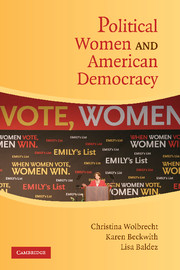Book contents
- Frontmatter
- Contents
- Preface
- List of Contributors
- Political Women and American Democracy
- 1 Introduction: What We Saw at the Revolution: Women in American Politics and Political Science
- 2 Gender as a Category of Analysis in American Political Development
- 3 Gender, Public Opinion, and Political Reasoning
- 4 Gender in the Aggregate, Gender in the Individual, Gender and Political Action
- 5 What Revolution? Incorporating Intersectionality in Women and Politics
- 6 Women's Movements and Women in Movements: Influencing American Democracy from the “Outside”?
- 7 Representation by Gender and Parties
- 8 Women as Candidates in American Politics: The Continuing Impact of Sex and Gender
- 9 Women as Officeholders: Linking Descriptive and Substantive Representation
- 10 Theorizing Women's Representation in the United States
- 11 Political Women in Comparative Democracies: A Primer for Americanists
- 12 Conclusion: Between Participation and Representation: Political Women and Democracy in the United States
- References
- Index
1 - Introduction: What We Saw at the Revolution: Women in American Politics and Political Science
Published online by Cambridge University Press: 05 September 2012
- Frontmatter
- Contents
- Preface
- List of Contributors
- Political Women and American Democracy
- 1 Introduction: What We Saw at the Revolution: Women in American Politics and Political Science
- 2 Gender as a Category of Analysis in American Political Development
- 3 Gender, Public Opinion, and Political Reasoning
- 4 Gender in the Aggregate, Gender in the Individual, Gender and Political Action
- 5 What Revolution? Incorporating Intersectionality in Women and Politics
- 6 Women's Movements and Women in Movements: Influencing American Democracy from the “Outside”?
- 7 Representation by Gender and Parties
- 8 Women as Candidates in American Politics: The Continuing Impact of Sex and Gender
- 9 Women as Officeholders: Linking Descriptive and Substantive Representation
- 10 Theorizing Women's Representation in the United States
- 11 Political Women in Comparative Democracies: A Primer for Americanists
- 12 Conclusion: Between Participation and Representation: Political Women and Democracy in the United States
- References
- Index
Summary
It is difficult now to imagine: in 1974, when Jeane Kirkpatrick and the Center for American Women and Politics (CAWP) conducted their groundbreaking research on female state legislators, Kirkpatrick (1974, 3) could write: “Half a century after the ratification of the nineteenth amendment, no woman has been nominated to be president or vice president, no woman has served on the Supreme Court. Today, there is no woman in the cabinet, no woman in the Senate, no woman serving as governor of a major state, no woman mayor of a major city, no woman in the top leadership of either major party.”
There were a few female political elites in 1974, but only a very few: women comprised about 6 percent of all state legislators (Kirkpatrick 1974) and less than 4 percent of members of the House of Representatives (CAWP 2006). At the mass level, however, the news was more promising: the gender gap in turnout was just 2 percentage points in men's favor in 1972, almost all of which was attributed to older women (Wolfinger and Rosenstone 1980).
Clearly, great strides have been made in the past thirty-some years. In 2007, women hold sixteen percent of seats in both the House and the Senate, and almost a quarter of state legislative seats. U.S. Representative Nancy Pelosi (D-CA) was recently elected madame speaker of the House. Women serve as governors of nine states and are mayors of seven of the fifty largest U.S. cities (CAWP 2007a).
- Type
- Chapter
- Information
- Political Women and American Democracy , pp. 1 - 11Publisher: Cambridge University PressPrint publication year: 2008
- 1
- Cited by



